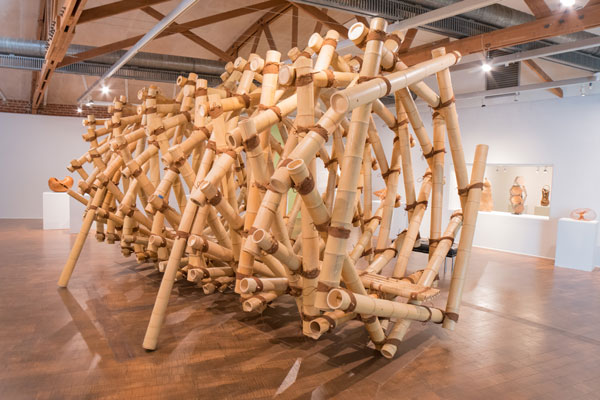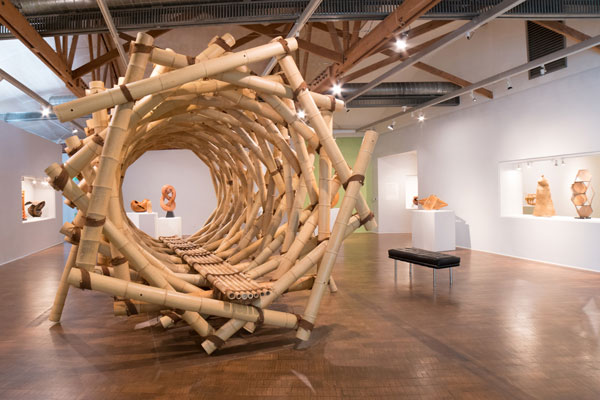The structure is made out of bamboo poles and stakes, secured with palm rope. It stretches from the side door leading out of the museum, crosses the small courtyard, and extends towards the street. The soft beige color of the Moso bamboo underscores the apparent simplicity of this tunnel/bridge, which was designed following the geometric and mathematical principles of the golden ratio and Fibonacci series. Those ancient proportions describe a progression of numbers that lays out a harmonious array in space. They reflect a progressive lengthening in measurement that has been found in nature, architecture and art. These formulas create a structure that is intrinsically pleasing and also underscores the way in which this artist and this exhibition are intent on both highlighting the use of certain materials from nature (renewable and sustainable) and decisive manipulations of that material, to talk more broadly about art creation in general.
Reminiscent of Buckminster Fuller geodesic domes and other types of utopian architecture worldwide, this sculptural composition by Akio Hizume is part of the exhibition “Bamboo” at the Craft and Folk Art Museum. Together they foreground the ethical underpinnings associated with merging this renewable, recyclable natural material together with very rigorous mathematical permutations and a determination to straddle the divide between fine art and craft.

Akio Hizume,
Fibonacci Tunnel, site-specific installation of bamboo and rope, 2018. Photos by Farah Sosa.
Fibonacci Tunnel (2018) physically arcs, bends and torques with an overlaid interweaving of bamboo strips to create a freestanding sculpture. The artwork can be traversed and in doing so one feels the pressure of the interlocking parts and how they sync and meld into one conjoined structure. The gentle segmental curving of the linear elements as they proceed from one end of the walkway to the other underscores the way in which some mathematical relationships are easily visible in something such as this sculpture and yet obscured in others such as the nearly invisible alignment of seeds in a sunflower. Part of the ultimate attraction of this work and the material with which it is made is the way in which together they suggest a less man-made intervention in the fabric of things. It is an almost idealistic depiction of the way in which meshing can accomplish that which the interlocking of fingers does: an ineffable but perceptible metaphor for inter-connectivity.
This manipulation of supple bamboo strands to create structures and forms is implicitly embedded in a conversation about Utopianism. Generally speaking, Utopianism is a way of imagining, dreaming, thinking about or tending towards a more cohesive relationship between society and nature. It is traced most often to Thomas More’s book Utopia in which the author described how to better English society, mapping out ways to modify the way people think about societal bonds and relationships with nature. Small experimental Utopian communities were formed in Europe and elsewhere but it has been left to the arts to use their means of expression as a way of suggesting Utopian relationships. In the natural consumption cycle of bamboo, and the technique of fastening that incredibly malleable material in the most elemental ways, a baseline Utopian theme resonates—keeping things local and directly modified.
Martin Puryear’s Big Bling (2016), Anish Kapoor’s Marsyas (2002–03), and Janet Echelman’s As If It Were Already Here (2015) are examples of works whose basis in mathematics and craft is superseded by shifts in scale. It is as though their intelligibility as contemporary art is assured by bracketing off or overlooking the logic that underlies them all, which is rooted in weaving.
Most of what goes by the name of conceptual is actually narrative. Contrast it with the directness of Mario Mertz’ Fibonacci Sequence 1-55 (1994), where the numbers are rather straightforwardly placed on the side of a chimney in Finland, or with the Fibonacci Tunnel of Hizume, in which the succession of linear elements simply reflects the scalar shifts.

Akio Hizume,
Fibonacci Tunnel, site-specific installation of bamboo and rope, 2018. Photos by Farah Sosa.
One of the most compelling aspects of thinking about and viewing these works is the way in which categorical divisions between things made by hand, things made by mind and things made by hand and mind are overcome or rendered meaningless. It is true that we need to discern between types of things but often that is a discriminatory process that sets up scales of value which in turn the utopian impulse obviates, defeats and ultimately ignores.


